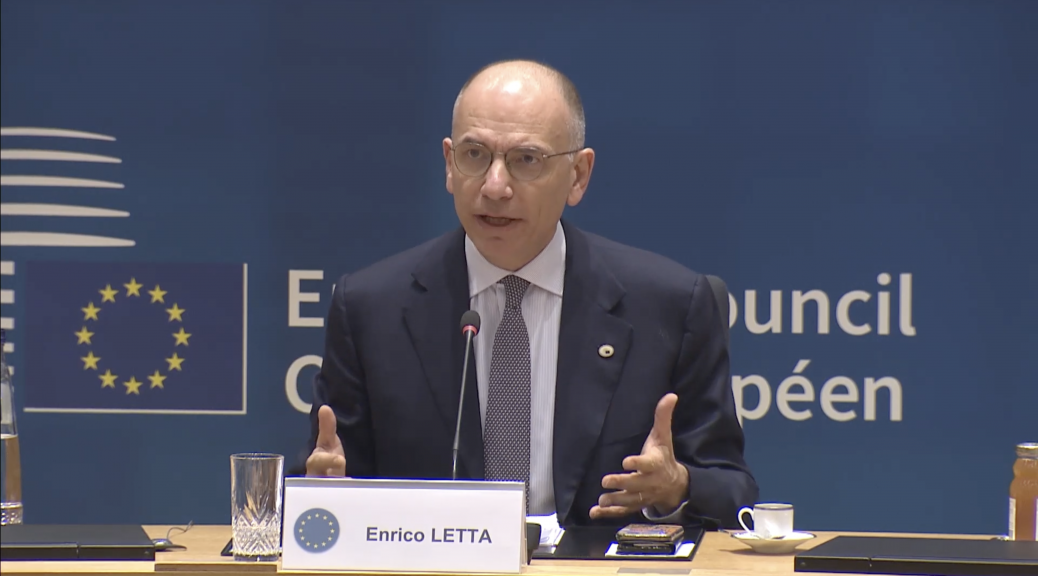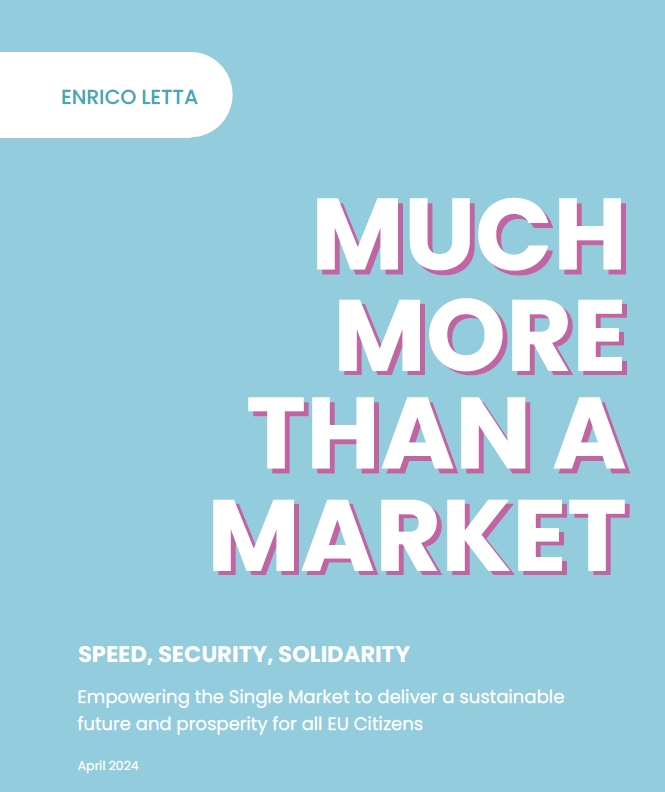
Much More Than a Market?
PDF-Version: Click here
Suggested Citation: Monti, DKartJ 2024, 14-18
Europe is preparing for the next Parliament, the next Commission – and all the challenges coming up these days. So, what is the European Union supposed to do, once the successors of Margrethe Vestager & Co. are sworn in? To be prepared, the institutions asked two Italian bigwigs for reports – the Council turned to Enrico Letta, the Commission to Mario Draghi. The Letta Report is now out, and D’Kart turned to another great Italian, Giorgio Monti, Professor at the Tilburg Law and Economics Center, to dissect the Letta Report. Here is his report on the report.
I have no idea why Enrico Letta’s report on the internal market issued in April 2024 is entitled Much More than a Market. Perhaps, heeding Jacques Delors’ quip that ‘nobody can fall in love with the single market’ he considered that proposing more could help make this report politically salient. However, there is nothing in this report beyond enhancing the internal market as defined in the EU Treaties wherein it is an element of a social market economy. This blogpost is divided in three segments. First, I comment on the style of the report; second, I briefly review the contents of the six chapters of the report; third, I discuss aspects of the report that may be of particular interest to the competition law community.

Style
One cannot help but draw comparisons with Mario Monti’s report, A New Strategy for the Single Market released on 9 May 2010. The symbolism for one: 9 May is Europe Day, the date when in 1950 we saw the Schuman declaration that launched the intergovernmental project which led to today’s EU. This one comes out mid-April, no particular symbolism attached. It also comes at the tail end of the current Commission and just before elections so it is not clear how much will be remembered by anyone when the EU resumes business after the elections. Two other things stand out. The first is that Monti’s report is much better composed: incisive analysis followed by precise recommendations. Letta’s is repetitive, with a great number of recommendations scattered throughout the text. Three ‘roadmaps’ with timetables are provided for some policy fields which raises the question as to why some items discussed have these detailed timetables and the rest (the vast majority) do not – are these more important?
The second is that you’d expect this report to show some frustration. Large swathes of it cover issues that Mario Monti had highlighted in 2010 as being key for moving Europe further (e.g. opening the services market, liberalizing network industries, making enforcement more effective), and little has been accomplished. Already in 2010 Monti referred to the single market as unfinished business with national regulations hampering economic initiative and innovation (p.37). And yet there is no anger at generations of politicians who have done little but react to pressing emergencies, frequently blaming the EU for unpopular choices.
Substance
The report contains six (unnumbered) chapters, each vaguely titled, all essentially rebooting the internal market in ways Letta thinks are necessary. Here I take a quick look at these chapters, with a warning that it is hard to synthesise a document that waffles on.
1: A fifth freedom. The EU created space for four economic freedoms: free movement of goods, services, capital and persons. This is the heart of the internal market, and the legal and economic salience of these freedoms is clear: Member States may not keep legislation that hampers these freedoms and EU Law may legitimately harmonise divergent national laws to enhance these market freedoms. Letta wishes to add a fifth freedom. What is this freedom? It is impossible to find a definition in the report. Freedom to what? Freedom from what? The best we get is this:
“This fifth freedom should encompass several fields, among which research, innovation, data, competences, knowledge and education.” (page 19)
The idea behind this can be one that one may agree on: Europe lacks a coherent technology policy, there is limited action to create skills, infrastructure and investment to achieve greater industrial leadership and the EU is lagging behind the US and China in ways that significantly hamper its capacity to lead on innovation in an epoch of major technological changes. But what this needs is not a freedom, but a coherent, EU-wide industrial policy. This is what the first chapter really recommends: “granting enhanced authority to a collective industrial policy at the European scale.” (page 20) Perhaps then, it is a plea for giving the Commission the freedom to coordinate the EU’s industrial policy further?
But rather than demanding Treaty reform (presently the EU has no industrial policy competence), the Letta report recommends stuff which is already going on (e.g. European Data Spaces), marginal tweaks such as supporting the mobility of researchers and innovators (free movement of people anyone?), and identifies fields where one should focus (computing power and AI) which are well known without proposing a concrete way to make the EU ‘a leading hub for AI innovation.’ (page 23). Why not be more radical and call for added EU powers to actually get things done?
2: Financing Strategic goals. As I have discussed elsewhere, the EU has to pay for any industrial policy. So far it has used creative ways to find public money to achieve this but it is clear that more needs to be spent and money has to be spent better. Letta is right in stating that the EU needs ‘a strategic approach that leverages the Single Market’s potential in obilizing both private and public resources more effectively.’ (page 26) This entails making capital markets work better and fixing state aid rules. I look at state aid below.
For capital markets, the report identifies three areas to make them work: increasing the supply of capital (e.g. stimulating investments by pension funds, insurance firms, retail savers), stimulating the demand for capital (especially access for small firms where he thinks what is needed is ‘fostering a culture of capital market utilization among SMEs’ (page 32)) and designing an institutional framework governing capital by better supervision of financial markets at EU level. The report recognizes that it may be difficult to negotiate a full transfer of supervisory powers to the EU and accompanies modest proposals in this regard with suggestions for improving the governance and decision making of the European Securities and Markets Authority. This is all sensible stuff, but it is not clear why the report does not also consider whether the EU should have a bigger budget as well. It isn’t as if private funders have a monopoly in wise spending.
3: Scale needed. Gone are the days of globalization moderated by the WTO: EU companies need to be large to ‘bolster the EU’s strategic autonomy, economic power, and global policy influence.’ (page 50) The report targets the followings sectors for regulatory intervention: finance (discussed in chapter 2) electronic communications, energy, transport, defence, outer space and health. The three network industries have been the targets of EU for decades. In telecom, the issues are well-known: more investment is needed in infrastructure (e.g. 5G Networks) and markets remain national – the report suggests that EU-wide operators could achieve the scale necessary for investment, noting that a unified approach to spectrum allocation is key to allowing the creation of larger players.
In energy markets the EU revealed its capacity for adaptation by finding alternatives to Russian gas, leading Letta to conclude that its response ‘has been more effective and united than in any other previous energy crisis’. (page 61) The proposal is to build on this momentum to stimulate the emergence of continent-wide markets to deploy clean energy. However, many initiatives already exist. The one new recommendation that emerges is to speed up the system of public funding by proposing a singe entity to manage clean EU energy funding. This is a direct response to concerns that the US IRA provides quicker funding because it is based on tax breaks. It has been over a year that the EU has considered policies to compete with IRA!
The new fields for intervention (defence, space and health) are probably the result of the two recent EU crises: Covid-19 and Russia’s invasion of Ukraine. For defence and space the report raises concerns about underinvestment and fragmentation of national markets – perhaps the latter is not so surprising since defence and space remain areas where states have guarded their autonomy. To fix defence, the report recommends consolidation of procurement by buying from local suppliers as a means to stimulate this sector. This requires money that the EU does not have but as the report shows Member States have this on the agenda, the one new idea here is to use the European Stability Mechanism (created to save the economies of certain countries during the financial crisis, repurposed already form Covid-19). This third use of this funding mechanisms suggests a deeper reform of the EU budget might be preferable.
4: Distributive justice. Economic growth has not been for all: one third of EU citizens live in regions that have not seen much if any of the positive effects of the internal market in the past twenty years. Addressing this is vital, we can all agree with this. However, the EU has limited competences to distribute wealth, so there is little to recommend. Letta suggests a rather bizarre new freedom (if there is a fifth freedom, it is found here not in chapter 1): the freedom to stay. Letta’s concern is that the only way many people use to improve their lot today is to leave impoverished regions which is a vicious circle as the brain drain leaves these regions even worse off, a ‘development trap’. (It was perhaps not wise for an Italian national to plead for the freedom to stay given that nearly 70% of young people aged 18 to 34 in Italy live with their parents, a right to stay clearly existing there!).
How to execute this freedom to stay: by rethinking regional aid as cross-border measures so that adjacent impoverished regions can benefit. No data is provided about how this might better redistribute wealth. Another more realistic suggestion made in the report is to offer grants and support for businesses, but without as we saw, any reflection on how to increase the size of the EU budget. Appointing a Vice President responsible for the freedom to stay (page 94) without a budget is unlikely to be useful. More sensibly, the report suggests that Member States take more ownership of their national budgets to deal with this, since they are competent. The EU would oversee this via the European Semester. Of course this process will do little to legitimize the EU as governments will blame the EU for higher taxes. By those same parties who seek election as MEPs.
5: Better EU-level law-making. This is an interesting chapter not least in light of complaints that the EU is only good at regulating industry rather than promoting it. These proposals stood out to me as particularly useful:
- ensuring more inclusive participation with a recognition that some interested groups lack the lobbying know-how of more experienced players and suggesting ways to make the former more engaged;
- regulating smarter, building in sunset clauses and facilitating experimentation;
- a Dynamic Impact Assessment that recalculates the costs and benefits when the European Parliament or Council recommend redrafting proposed legislation;
- reducing regulatory burdens by identifying redundant laws first and then reflecting on the fundamentals of regulation. In the regulation of digital markets this is particularly necessary as there are far too many under-examined links among the various Acts that have recently come into force.
6: External relations. As may be expected, the tone of this segment of the report reflects today’s ruptured times with an emphasis on security, competitiveness (a dangerous obsession), strategic independence and strategic partnerships (page 133). Since the EU has already moved to devise a policy in this direction, the report recommends building on this by adding to the list of technologies that must be de-risked (none identified though), and finding a framework of cooperation with ‘rival partners’ (no details here). It also suggests a Transatlantic Single Market (no detail) to improve relations with the US (page 142) which may be hard to weave together if you know who gets elected. Enlargements yes, but avoid more illiberal regimes a greater emphasis on ensuring candidates abide by the rule of law. Of all the chapters this is the most vague, perhaps necessarily so as this is the realm of geo-politics.

The Internal Market and Competition
Some will remember that when the current version of the EU treaties were being negotiated, the then French President asked “Competition as an ideology, as a dogma: what has it done for Europe?” This led to the Treaty draftsman relegating the EU’s aim of achieving undistorted competition to a protocol. It did not stop the Court of Justice quickly resetting the importance of competition policy, but certain elements of the Letta report show comparable signs that competition risks being sidelined. For example, he seems to accept the complaint that there has been ‘excessive entry’ of service operators in telecom (page 52). Can there really be too much competition? Relatedly, there are several calls for greater collaboration among firms and remarks that scale matters for the long term survival of EU industry given geo-political tensions and the need for strategic autonomy.
While the report continuously reassures us that scale should not come at the expense of competition, there is a clear call for some relaxation of competition rules which may mean more relaxed merger standards and a more lenient approach to exempting cooperation. A hint of how this might be operationalized is by reference to a dynamic approach consumer welfare (page 53) which suggests consumers may have to tolerate short run price hikes for long term innovation. This is an approach permitted in the Treaties, but is a major reorientation of competition policy that has so far been resisted, note for example the modest reformulation of the Guidelines on Horizontal Agreements.
The report confronts the regulation of state aid more directly The main concern is asymmetric spending by those who can afford this. The report suggests the introduction of a state aid contribution mechanism, by which Member States who grant aid are required to allocate a proportion of national funds to financing pan-European investments. It is not particularly clear to me how this can be achieved without an amendment to the Treaties. And absent any figures on how much this contribution might amount to, it is not even clear whether this is sufficient for anything. Moreover, the problem with state aid is that we don’t know how to distinguish between good and bad aid. This is largely because the procedure for authorization is front-loaded with states having to make an economic case for state aid without anyone having sufficient legal standing or knowledge to push back and without any ex post analysis of what state aid interventions have worked. These gaps need filling.
Conversely the report even suggests being quicker with disbursing cash especially for energy investments lest firms relocate to the US to take advantage of the IRA’s tax breaks. Again there is a tension between pursuing an active industrial policy that keeps investments here and a smart economic policy that makes the grant of state aid subject to better checks. Letta proposes solving this by adjusting the recent state ad policy of granting aid to important projects of common European interest (IPCEIs) which already require the contribution of state aid by multiple Member States and reaching multiple beneficiaries to facilitate the subsidization of long term strategic projects. One wonders, however, why the report considers this to be preferable to making the case for a bigger EU budget.
The discussion on public procurement reveals similar tensions between on the one hand praising this instrument while on the other bemoaning that Member States buy from the cheapest provider and remarking that there has been less competition for public contracts. The proposed solution to stimulate buyers to use this to enter into contracts that ‘foster the creation of high quality jobs, characterized by fair wages and conditions underpinned by collective agreements’ (page 46) may reduce competition further. Suggesting a minimum quota for innovation procurement is also an odd way of stimulating SMEs who might have less scale to promise innovation and this just seems another way of using state coffers to achieve EU goals.
Generalizing from this, it is hard to disagree with Jean-Francois Bellis that there is a risk, which this report just confirms, of the EU placing competition policy down one notch.

A report with rivals
While I have formed a generally negative impression of this report, perhaps the principal takeaways should be two. First, how hard it has been to build the EU market, how many complex issues must be addressed to make it work better, and how useless many national politicians have been. Second, one of the running themes of this report is how much more integration would be possible if Member States were more trustful of each other and pooled their resources. The report does well to identify all the complexities and junctures where greater cooperation may help.
But this is also its weakness: by covering so much and not pinning down a set of key priorities it reads like a report that has something pleasing for all, which in my view is not what we need now. Moreover, it is often hard to understand what the report proposes that is new when it often also explains existing policies. The text is also disorganized. For example: chapter 3 identifies some economic sectors, but other chapters identify additional sectors of focus (e.g. deep tech) so that there is no one place where a list of strategic industries is identified. Chapter 4 rightly looks at distributive justice but then pivots to consider the importance of consumer protection laws and new Code of Business Law to enhance competitiveness of SMEs who can use this to trade across the EU with lower costs, like the Uniform Commercial Code in the US. It’s like looking at an over-decorated Christmas tree.
We’ll see if the Mario Draghi report will bring greater focus and a sense of direction. In the meantime, the market for gaining the attention of new Commissioners and MEPs is filling up with rival recommendations, of which those by Jacques Pelkmans, a wise analyst of Europe’s internal market, is also worth a look.

Giorgio Monti is a Professor of Competition Law at the Tilburg Law and Economics Center and a research fellow at CERRE.